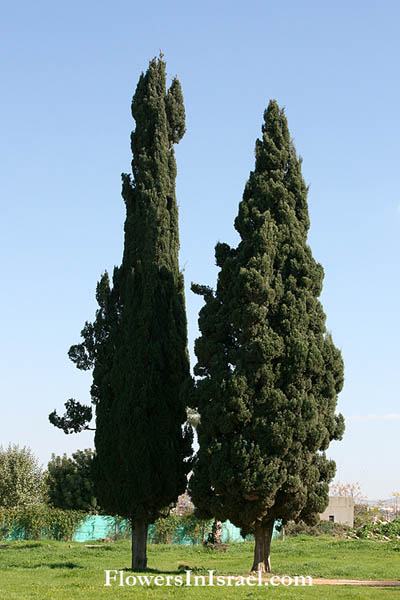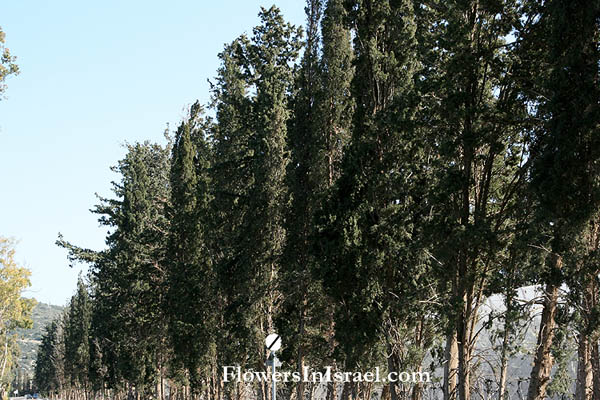Italian cypress, Funeral Cypress,
Hebrew: ברוש מצוי, Arabic: سرو اخضر افقي
| Scientific name: | Cupressus sempervirens L. | |
| Common name: | Mediterranean cypress, Italian cypress, Funeral Cypress | |
| Hebrew name: | ברוש מצוי | |
| Arabic name: | سرو اخضر افقي | |
| Plant Family: | Cupressaceae, ברושיים |

|
| Life form: | Phanerophyte, tree | |
| Stems: | Height: 12-22m; Spread: 3-4.5m; trunk straight; bark thin, smooth and gray for quite a long time, later becoming gray-brown and longitudinally furrowed | |
| Leaves: | Alternate, whorled, simple, entire,scale-like | |
| Flowers: | Green | |
| Fruits / pods: | Cones, oval, brown | |
| Flowering Period: | March, April, May | |
| Habitat: | Hard rock outcrops | |
| Distribution: | Mediterranean Woodlands and Shrublands | |
| Chorotype: | Mediterranean | |
| Summer shedding: | Perennating |

Derivation of the botanical name: Cupresssus, Kyparissos (Greek), κυπάρισσος, "cypress" — or Cyparissus (Latin: cupressus, "cypress"), which commemorates a youth of that name who killed his playmate stag, and begged the gods to let him mourn forever. Therefore he was turned into a cypress tree by Apollo. sempervirens, semper, "always"; virens, "to be green or verdant"; meaning evergreen. Te Hebrew name: ברוש, berosh perhaps a collective name for Abies cilcica, Cupressus sempervirens and Juniperus ecelsa.
A description of the site of origin of Cupressus was provided as well by the Roman philosopher Plinius: "cypress trees sprout spontaneously on Mt. Ida on the island of Crete, whenever the soil there is disturbed". The species was sometimes separated into two varieties, the pyramidalis, which has a columnar or narrowly conical shape, and the horizontalis in which the branches are horizontal. Cupressus sempervirens bears both serotinous and nonserotinous cones. Serotinous cones are alive and can live for at least 20 years. The production of serotinous cones is one of the adaptations of conifers to frequent fires. The cypress is monoecious, having both the male and female reproductive organs in the same individual and is wind pollinated. Because the branches of the pyramidalis cypress closely hug the vertical trunk and the tree resembles a candle, it is extensively planted in and around cemeteries. In Muslim graveyards in northern Israel the Cupressus sempervirens is the leading cemetery tree. The tradition of planting cypress trees in cemeteries stems from the sacred association of these trees with the Roman god Pluto (Greek: ᾍδης, Hadēs), who is the ruler of the underworld. The Egyptians associated cypress with death, and also connected cypress to the Egyptian beliefs of the afterlife. They used its fragrant wood for preservative properties, and in mummification and ascensions processes. A Byzantine legend is of cypress being one of the three symbolic trees that grow at the gates of the 'Symbolic garden', alongside the cedar wood tree and the pine, all said to teach us moderation. We can read many times about the cypress or brosh ((ברוש in the Bible: Sa2 6:5; Kg1 5:8, Kg1 5:10; Kg1 6:15, Kg1 6:34; Kg1 9:11, etc., a lofty tree (Isa 55:13) growing on Lebanon (Isa 37:24). Its wood was used in making musical instruments and doors of houses, and for ceilings (Ch2 3:5), the decks of ships (Eze 27:5), floorings and spear-shafts (Nah 2:3, R.V.). The precise kind of tree meant by a luxuriant cypress (Hos 14:8) is uncertain. Some regard it as the Cupressus sempervirens; others Pinus halepensis; while others think that the Pinus pinea is probably meant. During historical times, Cupressus sempervirens was so widely used in the East Mediterranean countries that it reached the brink of extinction. Nowadays it is planted on a large scale as an ornamental plant as a windbreak and as a forest tree. Practically, all trees found today in Israel west of the Jordan River have been planted by man. See the list of Medicinal herbs in Israel, the parts used and their medical uses to treat various diseases. Bible Resources:
|